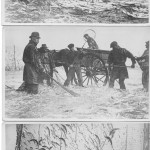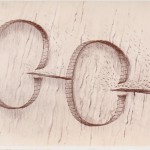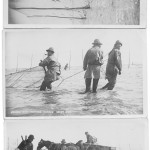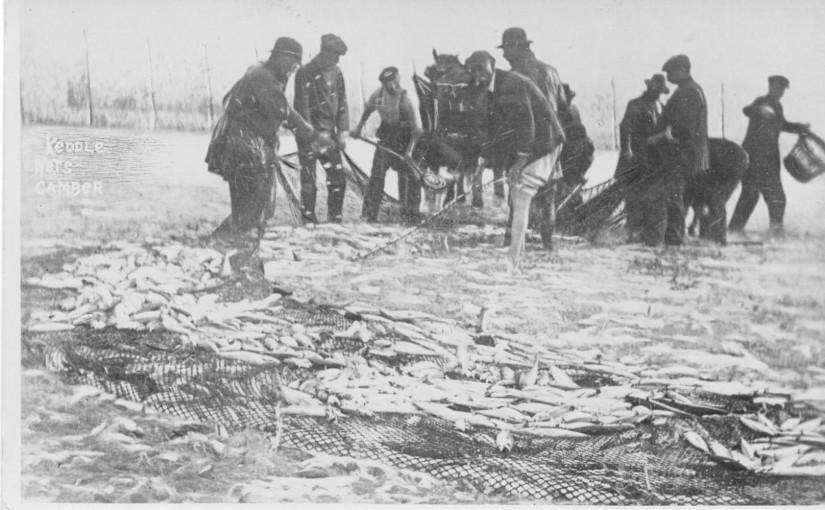Part One
BY JIMPER SUTTON
The Kettle, Kiddle or Keddle net as it is known around the Rye Bay area, is a very large trap type of net used around the coasts of Britain up to the end of the last century. It was used in many places where the tide went out and left enough sand or mud to work one. Five were still going in Wales up to the last war as also some were in the Thames Estuary, although they were very small affairs for the flat fish compared to the ones in Rye Bay, where they were often huge. They used large nets in Rye Bay for catching Mackerel or Herring that swam in great shoals.
WINCHELSEA WEST BAY
Keddle net fishing goes back in time and from it came the Drift net and Gill net that are to be seen in use the whole world over. From the thirty odd miles of Japanese drift nets it is a far cry from the passive keddle nets of the sandy bays of Rye and Hythe. The Domes Day book speaks of Hay nets or Fence nets around the shores of Rye and to this day nets are still set at Winchelsea by the Suttons, whose family can be traced backed to 1086 in this area. The family of Suttons have always kept records of their catches and they make fascinating reading.
Keddle nets started and up to recent times (1940) were set on poles, now they are not allowed to use any means of support other than a cork line to float the nets as the poles are a hazard to boats, bathers and Salmon Trout.
The layout of the nets are unique but there are other types of net used around England and Scotland that are similar, called Garths but they have floors and roofs to catch Salmon. The Keddle is different as it consists of a single sheet of net stopped on a ground rope every 8-10 inches for Herring and 10-20 inches for Cod and Bass.
The nets for Herring and Mackerel are 20-25 feet deep so as to float on the surface at high tide and still be tied to the sand. The nets consist of a range or pound/by the, the range is of approximately 50 yards long for Mackerel and Herring as they soon get tired of swimming along a net and turn away before reaching the pound.
Nets
A net is 50-60 yards long for catching Mackerel and Herring, they are two inch net e.g. 1 inch square hole and 20-25 feet deep. A rope is stopped onto the bottom every 10-20 meshes (8-10 inches), and the same along the top with a cork every 8-10 feet. The net used for the pound is stopped a little shorter along the top line than the bottom rope so that the net will hang in a cone when it floats. The range is stopped exactly like the pounds bottom line but the top is the same so that this net floats like a curtain.
The net is stopped on quite tight so as not to mesh fish and they need no lead line to sink them as they are tied tight to the sand on the fraps. The old nets used before the last war and up to 1960 were made of cotton or hemp, the very best were number 18 Salmon twine cotton dipped in tan, made from oak bark and tar. The nets were 660 meshes deep and 4000 meshes long and they came from Lowestoft off the Herring drifters and were all mended ready for use, once they had been cut into three making them 220 meshes deep, when wet they weighed one ton. Two ropes would be used along the top and bottom and these were called sole ropes. One would be spun right hand and the other left, when put together they would not twist. On the old pole nets corks were not used as the nets were held above the surface on the poles that were 18-20 foot high.
To keep the poles in place two or three pegs were first fixed to the bottom and then straw rope was tied around them. The next step was to dig a hole two to three foot deep in the sand, no mean feat in itself as anyone who has tried will tell you. Two men would have two spades chained together to dig with. Once the hole was deep enough the pole with the straw around it was quickly set up right and packed in with dry sand.
The Layout of the Net
The range usually starts at the foot of the beach where the sand begins and goes out to the low tide mark. On short neap tides you can only get three pounds on but on spring tides you may be able to swim 6-8 pounds e.g. 500 yards.
The range runs for fifty yards and then a pound, on the back of this pound is another fifty yard range and pound, and so on until you meet the low tide mark. The siting of a net of this type is very crucial as for it to be really effective it must be joined up, as one can see at low tide the sands differ Page Twenty-Seven along the length of the beach. Sometimes a stand will become a no go area after a gale because of a mud hole or gully appearing somewhere along the net, then it is time to move which is a very tiring business as the nets need hundreds of fraps to tie them down.
A frap is a piece of board 8-10 inches square with a hole in the centre which a rope is threaded through, a figure of eight knot is tied to stop the rope pulling out.
The Floating Keddle
The floating keddle net is just the same in shape and size only the corks replace the poles. The old pole nets were hung on pegs and tied to the poles, now floating nets are tied to fraps which are buried in the sand. The old fraps were made from old barrel staves which were cut into 8-10 inch lengths with a hole burnt in the middle, (many a nights have I spent with a hot poker filling the room up with smoke burning holes in frap boards). Through the hole a piece of rope is threaded and a knot is tied to stop the rope pulling through, this is then buried in the sand with the rope protruding and no amount of pulling will move it.
Nowadays the rope is synthetic and never rots, the old ropes would rot and you were forever replacing them. The sand of Rye bay must be full of them old barrel boards, we still dig them up at times now and being of oak they will never rot in the sea. Nowadays we use ply wood 10 by 10 inch square and make the holes using an electric drill. Fraps can be found all over the sands as we have to move the site of the net because of the shifting sands, you can not dig the fraps up because of the suction of the sand and you may be back one day.
The fraps like the poles are all set at the same distance apart, the reasons for this is so you can find them in the dark or buried in the sand and they also hold the net equal thus keeping the meshes apart. Along with fraps come main Guys, these are like fraps only much larger and the rope is as long as the net is deep and are tied to the top of the net to stop the sea tearing the corks off in rough weather. Not so many are used in the nets today as the synthetic material of the nets floats and so we use less corks but they are still an important part of the set up. They are used to tie the nets down so as not to catch too many unwanted fish and also to keep the nets under the water on high tides at weekends when so many speed boats come along the beach.
The old nets were so heavy that the fishermen had to use horse and carts to move them around, now with modern twines the use of a hand cart is all that is required and a van or trailer to take them home in. All nets have to be taken home now as they are stolen from the beach, cut up or set on fire, so is life today.
Years ago once a net was taken to the beach it never came home again, once it was taken off the sands it was scaled (spread) on the beach to dry and there it was safe until it was used again. Boxes and all the gear was left on the beach along with all the locals shrimp nets ready for the next time.
As the range of a Keddle net is set across the tide, anything and everything that drifts in the sea is caught. Once we caught a huge 100 gallon barrel that we thought was full of water and being unable to move it off the nets we knocked a hole in the end to let the contents out, OH DEAR, out gushed 100 gallons of sherry, that was the only time we caught anything of real value and we poured it out onto the sands.
Human bodies turn up from time to time, these we leave to the police thank you.
Hotel Key
Once I caught a hotel key from Sweden, it was attached to a piece of wood at least 10 inches by 4 inches with the room number and hotel address on it, I wrote a letter to the hotel explaining how I had come by it and sent it back. By return I received a lovely letter from them and an invitation to stay at their hotel if I was ever in Sweden. I have never gone.
Another tide after a gale the nets produced the main part of a German Messerschmitt with a live bomb attached. This the Army took care of, but by doing so tore up over 40 yards of net. The last time they came was three years ago when I found a bundle of cemtex detonators tangled in the nets. They had not long been in the sea as the cardboard box they had been in was still evident among the plastic strapping. First on the seen were the local police who called Page Twenty-Eight the Army in, when they arrived the first thing they did was put an exclusion zone of 300 metres around the net and no-one was allowed to use a mobile phone or radio as they could have set off the explosive charge in the detonators. You should have seen the white faces of the police, real shock. They had stood over them as they had radioed the information of the find to H.Q. this time I stayed and made the army untangle the mess, not just blow them up net and all.
50 Kilo Bomb
Another time we caught a 50kg bomb and the police got me and a mate to carry it up the beach, then the bomb squad arrived and carried it back out to sea to blow it up on the sands. I think next time I will leave it and let it wash away. Once we found a handbag that an American woman had lost overboard from a boat out of Southampton. Never got a thank you for that either, even though it had a lot of US dollars and all her papers in it.
A find worth having was a lobster pot after a blow and that did have a nice lobster and two fine crabs in it. I bet they wondered where they were going after the pot broke adrift for it must have come some way as no-one uses pots within twenty miles of Rye.
One very cold snowy day just after Christmas Dad arrived home with the bigger part of a fish that was over 5Ft in length, the reason for him bringing it home was that he had no idea what it was. It laid out in our back yard and was covered by snow that night. The scales of the fish were a bronze brown colour and over three inches in diameter, after a few enquires a friend had the bright idea that the TV would be interested in it, they in turn contacted a knowledgable man called Jack Hargraves who lived in Hampshire. He came to look at the fish that looked like a large Carp or Sturgeon, he poked and prodded it where it lay frozen in the snow then tried to prise some of the scales off but to his amazement found they were tied on with string, this really started things moving. The next step was to attack the frozen lump with an axe, on closer inspection it was found to be full of well frozen sawdust. What a scream, a stuffed fish, that was later established to originate from the Amazon region in South America and obviously brought home as a trophy. With the wind being eastly at the time Dad caught it, it was probably thrown in to the sea at Camber. Can you not just hear the wife saying to the husband, “Mother is coming for Christmas and that bloody stuffed fish has got to go, I don’t care what you do with it but get it out of this house”, boy did we have egg on our faces that time.
Being of such large size the Keddle nets could hold a very large shoal of fish as they did in may cases, this would be okay if only the shoals would spread themselves out but alas so often one shoal would be followed by another on the very next tide. At times the sheer numbers would overwhelm us, in the 1960s this happened one summer and the Mackerel were so thick that we could not clear the nets enough to take them off. The fish washed up the beach in a band of two to three feet wide along the tide line, it got so bad that the local WI complained to the council about the smell of rotten fish.
Flood of Cuttle Fish
At times Cuttle Fish would also fill the nets to overflowing and us kids had a lovely time having fights among them along with the holiday makers, especially the girls were good targets, as the fish flew through the air they would squirt ink out and boy could some of those London girls scream.
Another amusing incident occurred in the summer of the sixties when there was a fete on in Winchelsea Beach. Somehow as we passed with a lorry full of Mackerel someone threw something at us, so we threw back at them Mackerel, this turned into a right royal battle with hundreds of fish flying through the air. The star of the fete was Spike Milligan and he got his shirt stuffed full of Mackerel, but it was all good fun and the fete was to raise money for a rescue boat after a boy had drowned at the beach that summer. Two boys had gone to sea in a canoe they had built but it sank. One of the boys was saved by another boy called Baggy Sams from Icklesham but alas John Wilkinson drowned. On the day he drowned the rescue helicopter landed at the nets as they saw one hundred people standing in a circle and thought it may have been the boy they were looking for but it was only our nets and fish that people were interested in. We gave them two boxes of Mackerel to take back to Manston.
War Years
Up to now the life of a keddle netter had been just one tide after another. Fish was washed boxed and sent to markets. Now appeared the first sign of authority with the Ministry of Food. The Foreshore was out of bounds to anyone without a pass and the selling of fish to people as you worked was not allowed so all the fish had to go to Rye into a market run by the Bellhouse M.A.F.F and prices were set, so for the first time the fisherman knew what he would get for his catch.
As keddle nets were on the sands, there was no risk to life, as at sea with submarines and mines. But as we will see it was still very dangerous. In 1939-40 there were only two netters left on Winchelsea beach as the others had been called up.
My Father had a special permit to enter the zone but was only allowed on the sands in daylight and could be seen easily. A few times German aeroplanes shot them up on the sands and Father had a cart right up into the sixties that had machine gun bullets in it. Later the Canadian army that were stationed in the area found out about the fish that was being caught and the colonel made enquires into having a net of his own. My Father told him that if he could get some nets he could show them how to fit them up. The next day he was amazed to find three army lorries pull up full of herring nets that they had got from Lowestoft drifters that were no longer fishing. But on mine sweeping operations the next step was to make fraps and set it out. My Father told the officers what was needed and over a hundred men arrived the following day with spades. The army had four sets of keddle nets on at once and landed over 60 ton of fish one week. Now the army were involved the day only rule was suspended and the night tides were fished as well. ( see Eileens letter )
The Canadians loved Mackerel and their cooks had a recipe for them that called for Bayleaf. After the war there was hardly a Baytree left within three miles from Winchelsea that the Canadians had not pruned, sometimes only leaving two inches of stump. The war years saw a tremendous jump in the sort of fish caught, believed to be the result of not a lot of fishing in the channel and a reduction of traffic.
Plaice catches reached highs in the 1940s, over 40 stone a tide. These were sold at the Bellhouses for 3 shillings and 4 pence a stone and on top of this there was a war subside of 4 pence a stone, Father had a permit to Hawk fish and a petrol ration to go with it, this was quite a thing to have in a restricted area.
Pilchards, a fish not seen around this part of the coast now in huge numbers, was a big thing in the war when huge shoals swam up the channel. We have a landing bill for 260 stone of Pilchards sold by Adams of Hastings that my Father caught in one tide and on the bill Father wrote THE HARDEST DAYS WORK I HAVE DONE. Just think, go down on the sands and find one and half ton of fish to be picked up one at the time and then carried up the beach.
Another time he was on his way to Hastings with a good catch of Plaice and as he drove up Winchelsea hill the side of the van fell out and the fish slid all over the road (this was before MOTs and so many hygiene rules.
First Published in “Rye’s Own” November 2015
All articles, photographs, films and drawings on this web site are World Copyright Protected. No reproduction for publication without prior arrangement. (Hard Copy Back Numbers Still Available) © World Copyright 2017 Cinque Ports Magazines Rye Ltd., Guinea Hall Lodge Sellindge TN25 6EG
